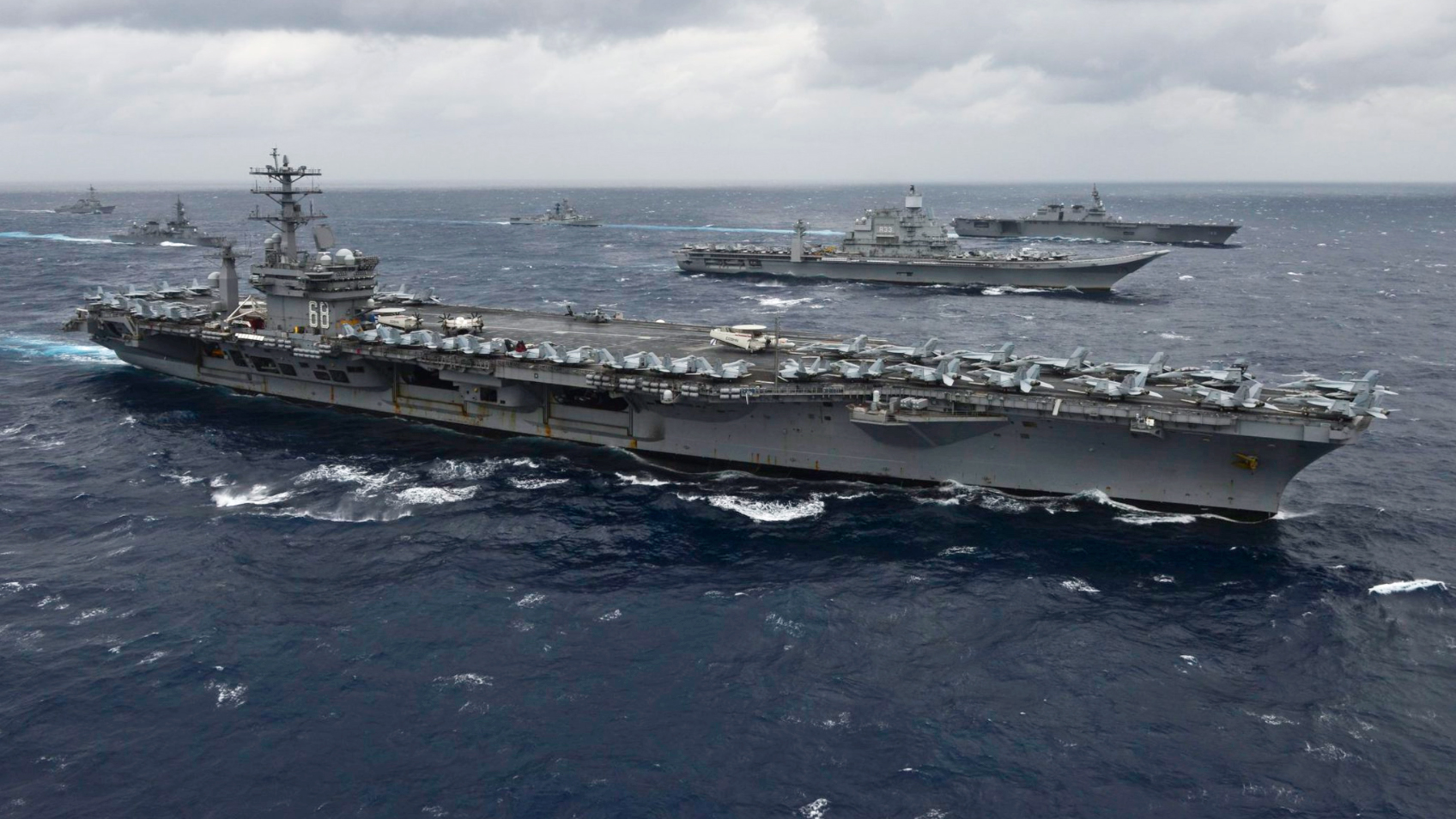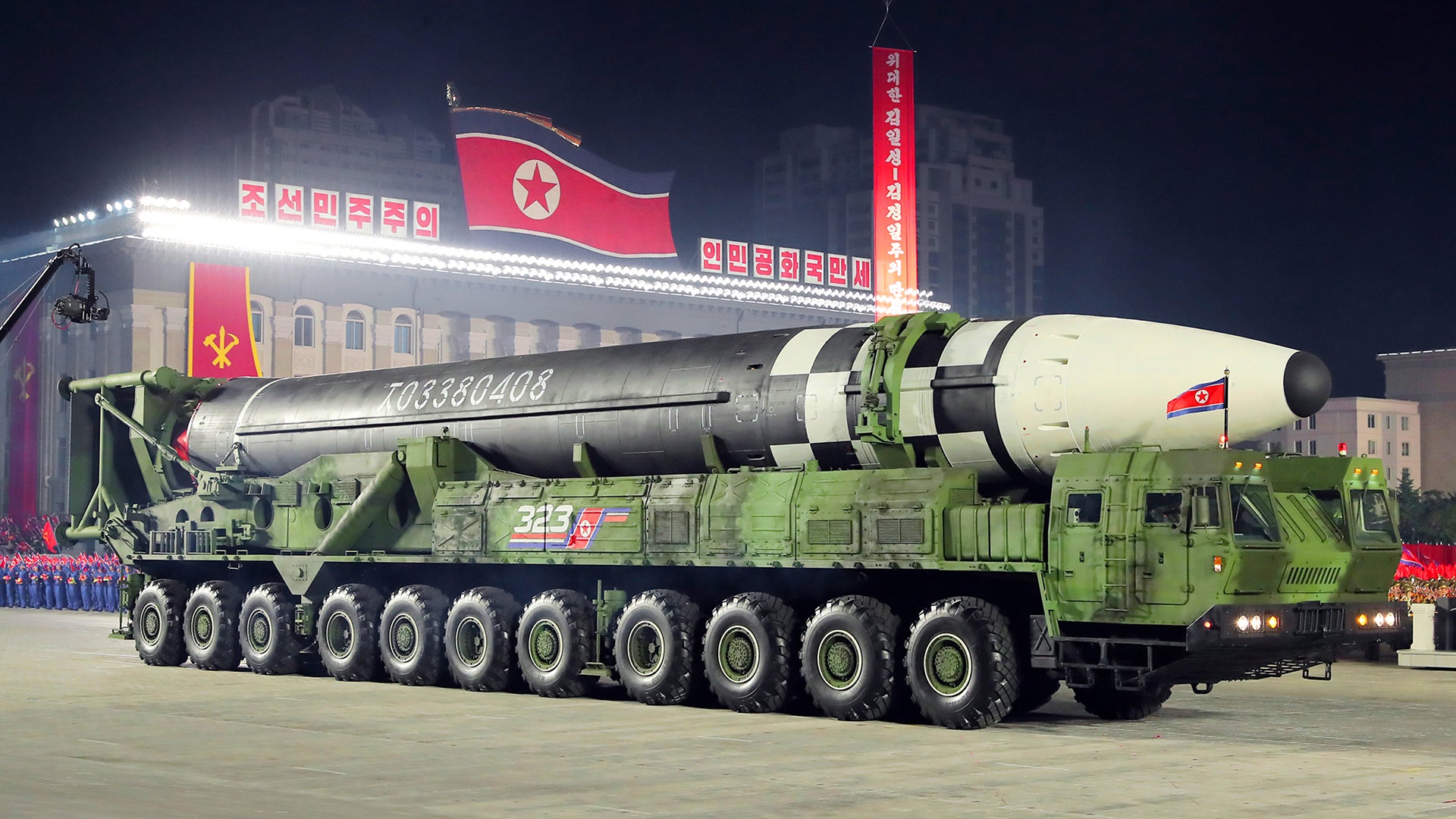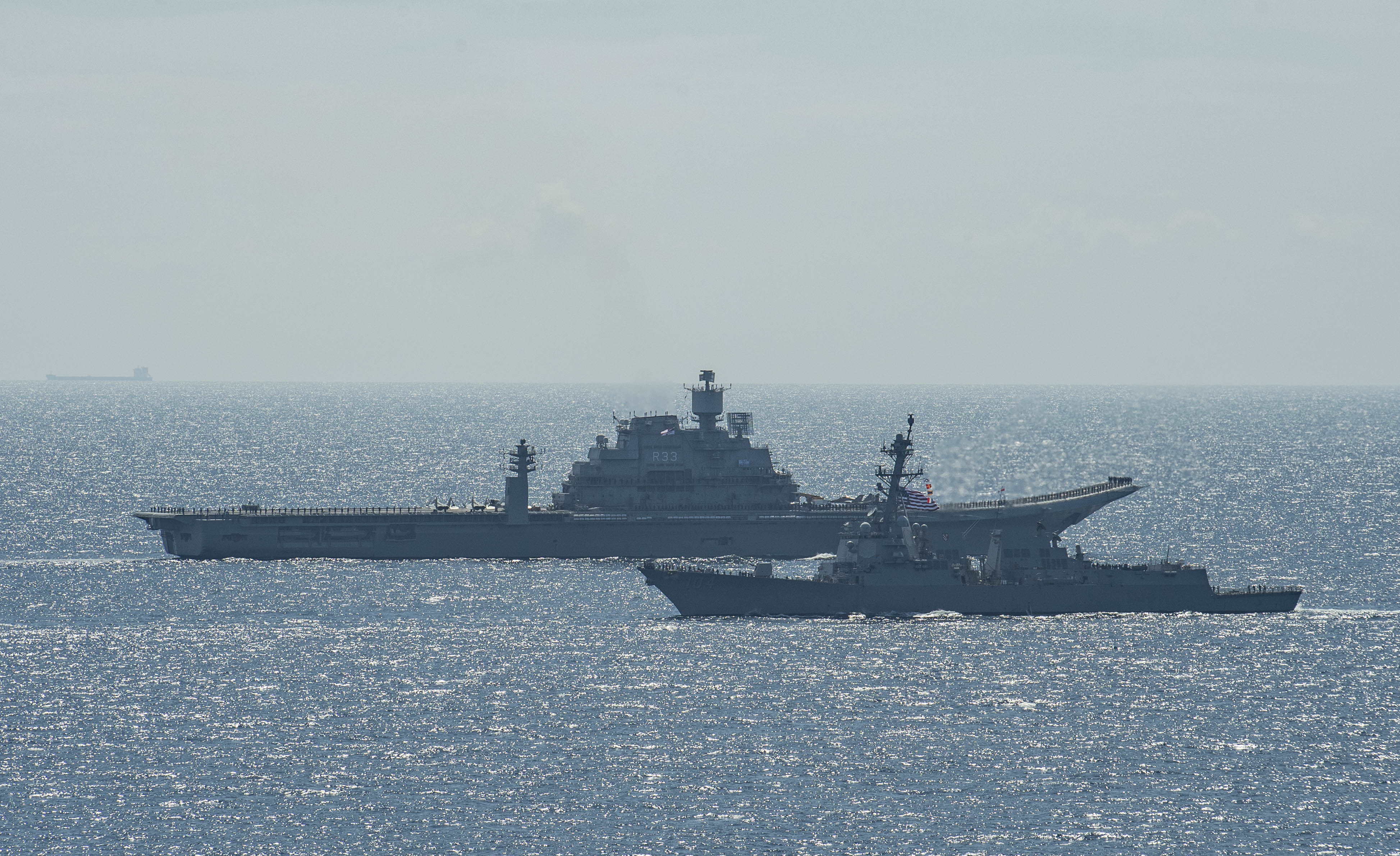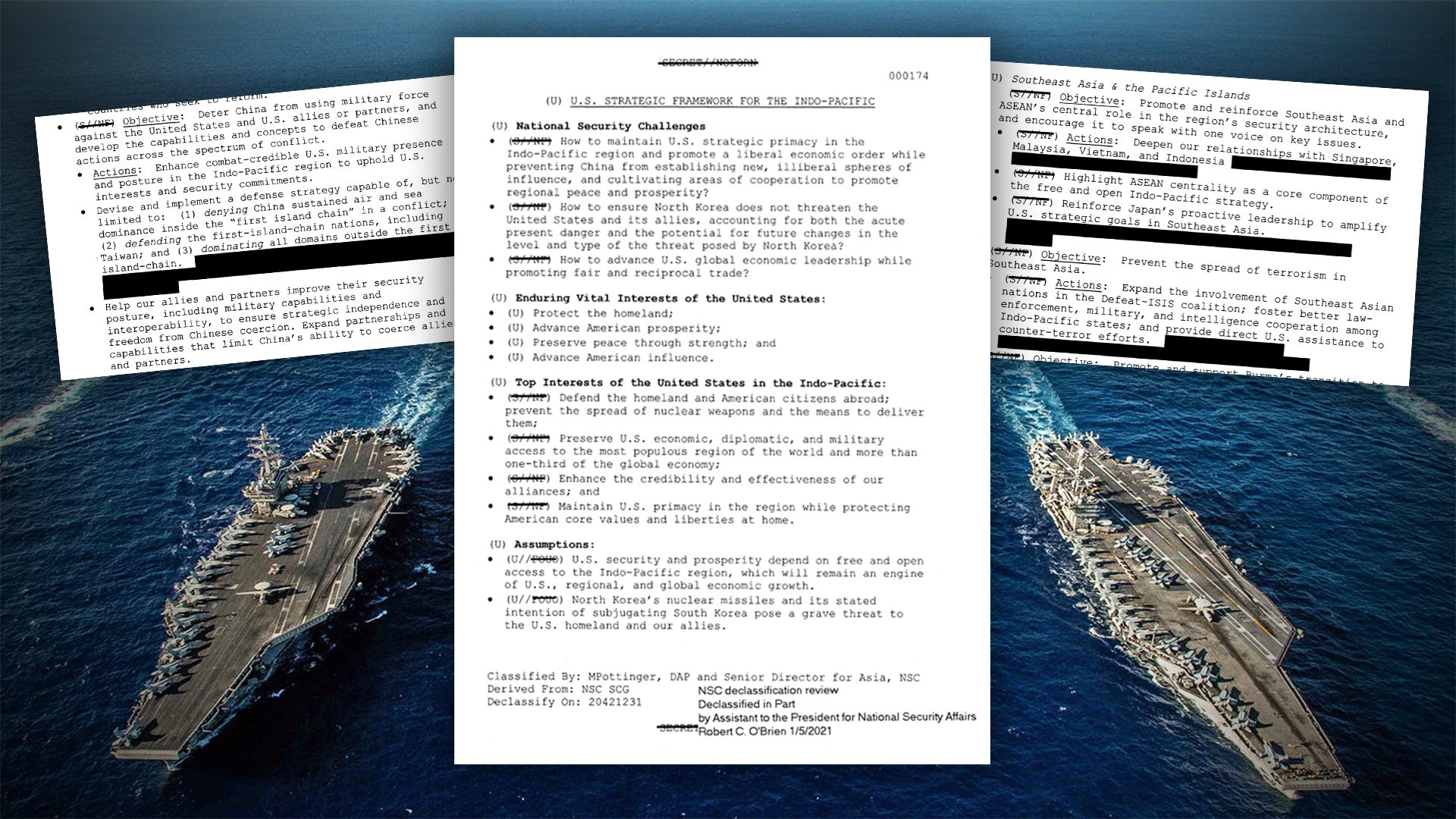The U.S. government has just declassified a critical national security document, the 2018 Indo-Pacific strategy, which, for the last three years, has provided the template for U.S. policy in this strategically vital region, spanning from the west coast of the United States to the west coast of India. In particular, the strategy outlines ways to counter Beijing’s burgeoning influence in the Indo-Pacific, plans to deal with an increasingly bellicose North Korea, as well as the importance of strengthening India as a military counterbalance to China.
The strategy document was drawn up by the National Security Council (NSC) over the course of 2017, before being approved by President Donald Trump in early 2018, soon after the release of the National Defense Strategy, which you can read more about here. Previously classified as secret and not intended to be publicly releasable in any form before the very last day of 2042, the report was made available online late on January 12, with only minor redactions. Exactly why it was released now has not been clarified.

While the exact authors are unknown and the document was the product of a multi-agency effort, H.R. McMaster, then Trump’s National Security Advisor, and Matt Pottinger, the NSC director for Asia at the time, and subsequently Deputy National Security Advisor, would have been among those involved. McMaster resigned from this post in March 2018. Pottinger was one of the officials to resign last week, following the storming of the Capitol in Washington, D.C. by pro-Trump supporters. You can read more about that dramatic episode here.
Although much of the document is clearly in line with what has already been seen of the Trump Administration’s actions in the Indo-Pacific in the past three years, it nonetheless provides a useful crystallization of U.S. interests in the region, as evidenced by the following passage:

Beyond that, is it worth looking in more detail at the most pertinent points of the document, in particular how the United States views its key adversaries and partners in the region, particularly China, North Korea, and India.
The main threat: China
As one of the most dominant powers in the Indo-Pacific, and one increasingly identified by the U.S. government as its chief opponent and strategic challenger in the region, it is not surprising that China is identified as the U.S. government’s primary concern. There is certainly no end in sight for the strategic rivalry between the two countries whose political and economic systems are so at odds.
The document sets out the key national security challenges for the United States in the region, including “How to maintain U.S. strategic primacy […] and promote a liberal economic order while preventing China from establishing new, illiberal spheres of influence, and cultivating areas of cooperation to promote regional peace and prosperity.” It also provides a warning that “China will circumvent international rules and norms to gain an advantage” when it comes to the strategic competition between the two powers.
There is little mention of the specific military strategies that China is using to assert its regional dominance, but there is an explicit reference to Beijing’s “proliferation of its digital surveillance, information controls, and influence operations [that] will damage U.S. efforts to promote our values and national interests in the Indo-Pacific region and, increasingly, in the Western hemisphere and at home.” Separately, the U.S. government has publicly identified matters of military concern in regards to China, especially its growing nuclear arsenal, long-range ballistic and cruise missile capabilities, and naval capacity, among others.
An official video from the Chinese Ministry of Defense from last year depicting a hypothetical attack on the U.S. airbase on Guam:

The document does provide an overview of a broader defense strategy aimed toward China and which specifies a posture that is “capable of, but not limited to: (1) denying China sustained air and sea dominance inside the “first island chain” in a conflict; (2) defending the first-island-chain nations, including Taiwan; and (3) dominating all domains outside the first island chain.” The first island chain refers to the major archipelagos nearest the east Asian mainland, stretching from Russia’s Kamchatka peninsula to the Malay peninsula and including the Japanese archipelago, Taiwan, and the northern Philippines. Much of the waters within this approximate boundary are contested and claimed by China, which meanwhile possesses a capable and fast-expanding navy.
Not mentioned specifically in the document, but surely in the minds of the authors, are China’s expansive and almost universally disputed territorial claims, particularly in the South China Sea, but also in other parts of the broader Western Pacific. The South China Sea and adjacent bodies of water have seen a notable increase in Chinese military activity, but also in activities by the United States and its regional allies and partners.

In practical terms, the U.S. relationship with China has steadily deteriorated under the Trump administration, including an ongoing trade war targeting Chinese companies considered to be a threat to national security, while on the military side, the United States has not only been proactive in demonstrating its ability to protect allies and interests in the region from Chinese aggression but has also committed itself to the defense of Taiwan, evidenced by a number of big-ticket defense deals with the island nation. There have also been attempts made by Trump to blame China for the COVID-19 pandemic, accusing its government of not having managed the first outbreak adequately. Meanwhile, under Trump, the relationship between the United States and Taiwan has expanded beyond just arms sales, to include training and increased diplomatic engagement.
Tackling a nuclear North Korea
After China, the 2018 strategy framework identifies the next biggest threat in the Indo-Pacific is North Korea. This document’s viewpoint and language would have been directly influenced by the various provocative missile tests that took place in 2017, which also demonstrated the rapid advances Pyongyang had made with regards to various types of military technology. The document notes that North Korea’s “nuclear missiles and its stated intention of subjugating South Korea pose a grave threat to the U.S. homeland and our allies.”
It is worth noting that the Trump Administration, and Trump personally, had already been pursuing an extremely aggressive policy toward North Korea in 2017 — before the document was actually approved. This even extended to threats implying the use of nuclear weapons. This strategy was developed as U.S. policy was shifting to detente in the lead up to the meeting between Trump and Kim Jong Un, as well as the softening of the relationship between North Korea and South Korea.

The 2018 document identifies the roles that both Japan and South Korea can play in helping the U.S. attain its objectives vis-à-vis North Korea, which include removing not only nuclear weapons, but also chemical, cyber, and biological weapons from the Korean peninsula. To help facilitate this, it calls for the United States to assist South Korea and Japan in acquiring “advanced, conventional military capabilities” and to draw South Korea and Japan closer together. Although, at least in redacted form, it does not provide clues as to how the latter would be achieved
The key objective in the United States dealings with North Korea is to “Convince the Kim regime that the only path to its survival is to relinquish its nuclear weapons” and a whole raft of tools are highlighted as a means of achieving this, including applying pressure by economic, diplomatic, military, law enforcement, and intelligence, and information means. Negotiations are listed as an option if and when North Korea takes steps to reverse its nuclear and missile programs.
While the Trump administration did follow through with direct talks with Kim Jong Un, the outcomes turned out to be, largely, failures. Against the backdrop of this, the relationship between Trump and Kim apparently evolved into something of an infatuation on the part of Trump, too. It is notable that Bill Burns, President-elect Biden’s choice for the next head of the Central Intelligence Agency, has talked about this specific point recently and its clear pitfalls.
India as a vital strategic partner
The strategy overall promotes strategic alignment with allies and partners in the region, including the desire to “to create a quadrilateral security framework with India, Japan, Australia, and the United States as the principal hubs.” However, India in particular is identified as a key regional partner and as a potential bulwark to offset Beijing’s power and influence. “A strong India, in cooperation with like-minded countries, would act as a counterbalance to China,” the document states. It also notes that “India maintains the capacity to counter border provocations by China,” although the document pre-dates the latest round of skirmishes between China and India in Ladakh and the Tibet Autonomous Region, where the enduring military standoff between the countries escalated significantly last year.
The strategy document came out before the India-Pakistan conflict in 2019 and actually makes no mention of Pakistan at all, despite Pakistan’s very close and significant ties to China and China’s aggressive efforts to redefine the status quo along its border with India.
The document calls for efforts to “Accelerate India’s rise and capacity to serve as a net provider of security and Major Defense Partner; solidify an enduring strategic partnership with India underpinned by a strong Indian military able to effectively collaborate with the United States and our partners in the region to address shared interests.”

Ultimately, however, as international security expert Ankit Panda has pointed out, the broader aspects of the role played by India within the U.S. Indo-Pacific strategy is a continuation of that contained in policy dating back to the second Bush administration.
In concrete terms, under the Trump administration, the U.S. Navy has looked at establishing a new naval command with a particular focus on the Indian Ocean and adjacent areas of the Pacific. It has also been engaged in a cycle of large-scale maritime exercises involving the Indian Navy, as well as those from Japan and Australia, in the region. The U.S. military, as a whole, has also been working to strengthen ties with its Indian counterparts in this general region, in order to challenge China’s growing geopolitical ambitions. The U.S. has also begun to look at options for fielding longer-range strike capabilities in Asia as a direct counter to Beijing’s own missile forces.
Meanwhile, significant arms sales, and big-ticket pitches, to New Delhi have continued apace and Lockheed Martin, for example, rebranded its latest advanced F-16 offering for India as the F-21 as it seeks to expand industrial cooperation in India. Some observers have even suggested that this might even pave the way for India to join the F-35 Joint Strike Fighter program.
Has it worked?
Overall, despite the bold outlining of strategy in the Indo-Pacific, a good deal of the document’s aims remain unachieved, notably managing China’s growing power and influence. Communist China seems as ascendant as ever and is continuing to pursue very hardline policies in places like Xinjiang against the Uighurs and political dissidents in Hong Kong, with relative impunity. Tellingly, there is no mention made in the document of human rights abuses by Beijing.
Similarly, attempts to remove nuclear weapons from North Korea have been a total failure. North Korea’s nuclear arsenal has reportedly grown and there are new rumblings of potential North Korean missile or nuclear tests in the coming year to challenge both the United States and South Korea.
On the other hand, progress has been made, too. The aforementioned new numbered U.S. Navy fleet is due to be created to cover the Western Pacific, freedom of navigation drills have increased in frequency, and serious efforts have been made to empower and rearm Taiwan. Multi-national military exercises with key allies in the region have also continued to grow in scope and inclusivity.
It is probably still too early to tell what the exact legacy of the Trump administration’s policies will be, in the end. Furthermore, we also don’t know how much of this general strategy will or won’t be carried over to the Biden administration.
Regardless of these uncertainties, the strategy document provides an interesting view of how the Trump administration has been tackling issues in what is one of the most important and volatile regions on the planet.
Contact the author: thomas@thedrive.com
